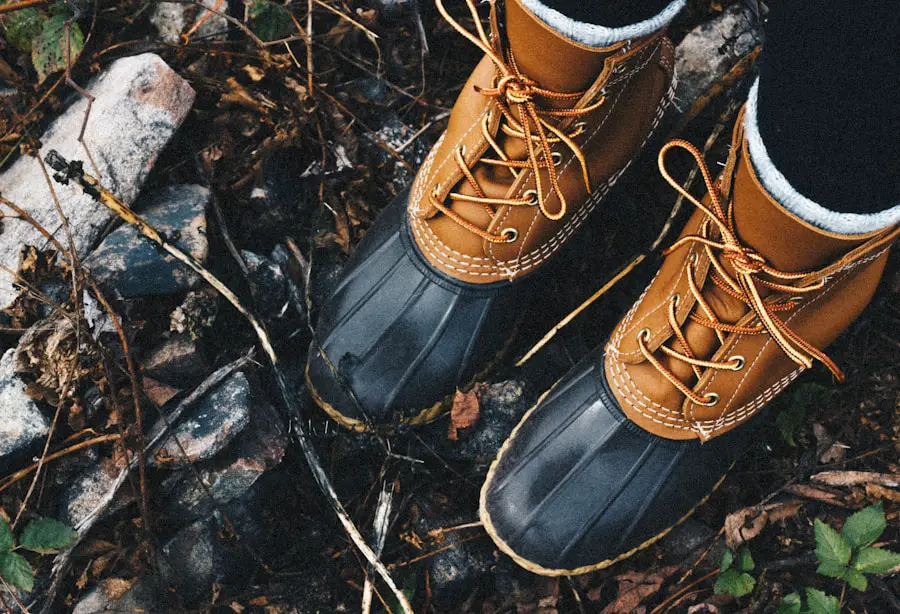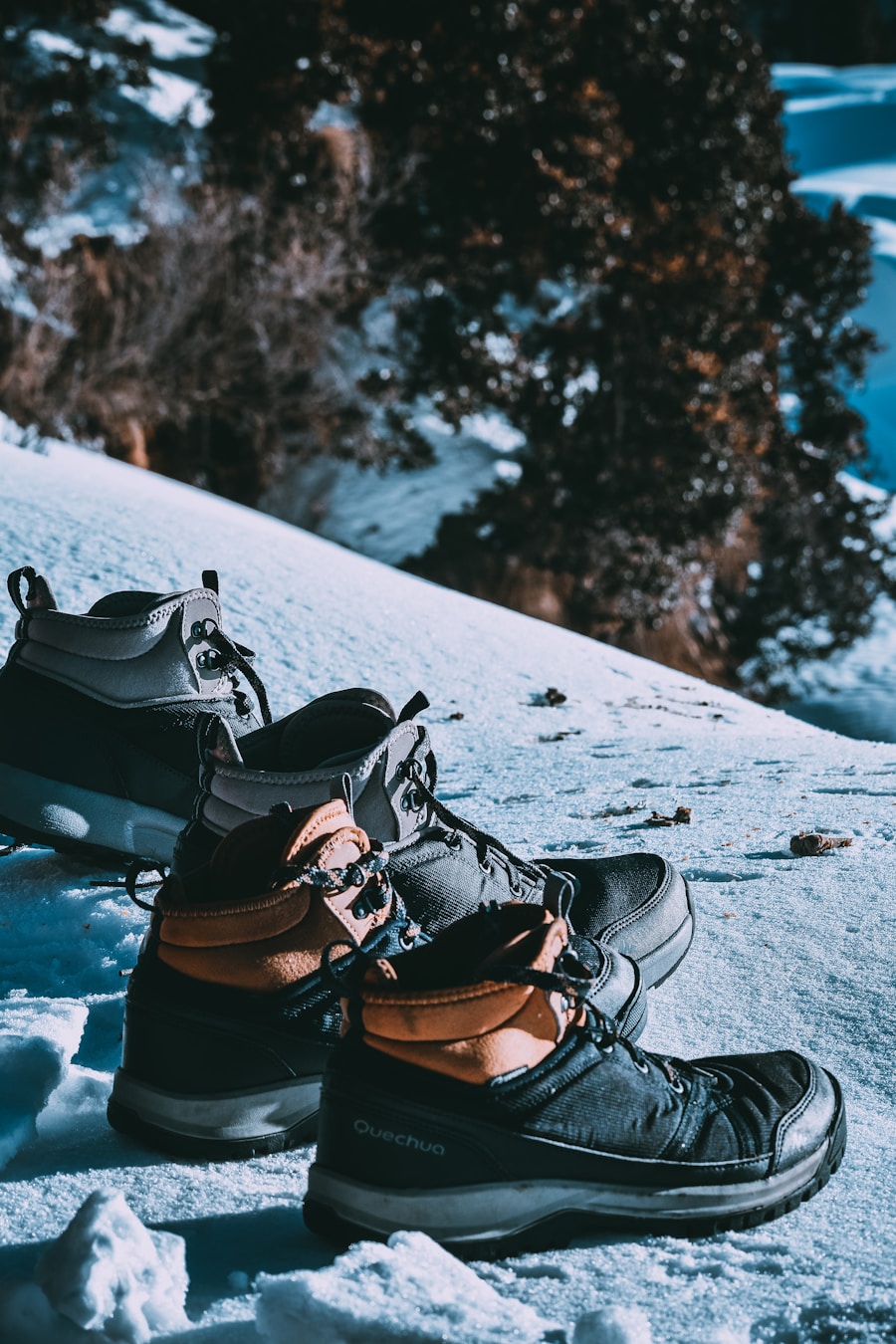Before embarking on a hiking adventure, it is crucial to assess your specific hiking needs. The type of terrain you plan to traverse, the duration of your hikes, and the weather conditions you expect to encounter all play significant roles in determining the right footwear. For instance, if you are planning a multi-day trek through rugged mountain trails, you will require a different type of boot than if you are simply taking a leisurely stroll on well-maintained paths.
Understanding these factors will help you make an informed decision when selecting the appropriate hiking boots. Additionally, consider your personal hiking style and experience level. Are you a seasoned hiker who frequently tackles challenging trails, or are you a beginner looking to explore local parks?
Your experience can influence the level of support and protection you need from your boots. For example, novice hikers may benefit from lighter, more flexible boots that allow for easier movement, while experienced trekkers might prioritize stability and ankle support in more robust models. By evaluating your hiking needs, you can narrow down your options and find the perfect pair of boots that will enhance your outdoor experience.
Key Takeaways
- Understand your hiking needs before choosing a pair of hiking boots
- Consider different types of hiking boots such as light hiking, backpacking, and mountaineering boots
- Pay attention to fit and comfort, including the importance of trying on boots with the right socks
- Materials and construction play a key role in the performance and durability of hiking boots
- Look for waterproofing and breathability features to keep your feet dry and comfortable on the trail
Types of Hiking Boots
Hiking boots come in various styles, each designed for specific types of terrain and hiking activities. Broadly speaking, they can be categorized into three main types: lightweight hiking shoes, mid-cut hiking boots, and heavy-duty backpacking boots. Lightweight hiking shoes are ideal for day hikes on well-maintained trails.
They offer flexibility and comfort, making them suitable for casual hikers who prioritize ease of movement over extensive support. Mid-cut hiking boots provide a balance between lightweight shoes and heavy-duty boots. They typically offer more ankle support than lightweight options while still being relatively light.
These boots are versatile enough for various terrains, making them a popular choice for hikers who venture into moderately challenging trails. On the other hand, heavy-duty backpacking boots are designed for serious trekkers who carry heavy loads over rough terrain. These boots are constructed with stiffer materials to provide maximum support and protection, making them essential for long-distance hikes in challenging environments.
Considerations for Fit and Comfort

When selecting hiking boots, fit and comfort should be at the forefront of your decision-making process. A proper fit is essential not only for comfort but also for preventing blisters and other foot injuries during your hikes. It is advisable to try on boots at the end of the day when your feet are slightly swollen from daily activities.
This will give you a more accurate sense of how the boots will feel during extended wear. Pay attention to the width and volume of the boot as well. Some brands offer different widths to accommodate various foot shapes, while others may have a more universal fit.
Ensure that there is enough room in the toe box to wiggle your toes without feeling cramped, as this can lead to discomfort on long hikes. Additionally, consider wearing the socks you plan to use while hiking when trying on boots to ensure a proper fit with your chosen sock thickness.
Materials and Construction
| Category | Metrics | Value |
|---|---|---|
| Materials | Steel consumption | 1.86 billion metric tons |
| Construction | Global construction output | 11.4 trillion |
| Materials | Concrete production | 4.1 billion metric tons |
| Construction | Number of construction workers worldwide | ~ 7.6 million |
The materials used in the construction of hiking boots significantly impact their performance and durability. Common materials include leather, synthetic fabrics, and rubber. Leather is known for its durability and water resistance, making it an excellent choice for rugged terrains.
Full-grain leather offers superior protection but may require a break-in period. On the other hand, nubuck leather is softer and more flexible but may not be as durable as full-grain options. Synthetic materials, such as nylon or polyester, are often lighter than leather and can provide excellent breathability.
These materials are typically used in lightweight hiking shoes and mid-cut boots. However, they may not offer the same level of durability as leather in harsh conditions. The construction method also plays a role in the boot’s overall performance; for instance, boots with a cemented construction tend to be lighter but may not be as durable as those with a Goodyear welt construction, which allows for resoling when the soles wear out.
Waterproofing and Breathability
Waterproofing is a critical feature for hiking boots, especially if you plan to hike in wet or muddy conditions. Many manufacturers incorporate waterproof membranes like Gore-Tex or proprietary technologies that keep water out while allowing moisture from sweat to escape. This balance between waterproofing and breathability is essential for maintaining comfort during hikes, as damp feet can lead to blisters and discomfort.
However, it is important to note that while waterproof boots can keep your feet dry in wet conditions, they may sacrifice some breathability compared to non-waterproof options. If you anticipate hiking in hot weather or dry conditions, consider whether waterproofing is necessary for your needs. Some hikers prefer breathable mesh materials that allow for better airflow but may not provide adequate protection against water exposure.
Traction and Support

Traction for Stability
Traction is a vital consideration when selecting hiking boots, as it directly affects your stability on various terrains. The outsole of the boot plays a significant role in providing grip; rubber compounds with deep lugs are often preferred for their ability to grip uneven surfaces effectively. Vibram outsoles are particularly renowned for their durability and traction across diverse terrains, making them a popular choice among serious hikers.
Support for Comfort
Support is equally important, especially if you plan to carry a heavy backpack or hike on uneven ground. Look for boots with features such as cushioned midsoles that absorb shock and provide comfort during long treks. Additionally, consider the height of the boot; higher-cut models offer increased ankle support but may feel restrictive for some hikers.
Balance for the Best Hiking Experience
Ultimately, finding the right balance between traction and support will enhance your overall hiking experience.
Durability and Maintenance
Durability is a key factor when investing in hiking boots, as they are subjected to harsh conditions and rough terrains. High-quality materials and construction methods contribute significantly to a boot’s longevity. Leather boots tend to be more durable than synthetic options but require regular maintenance to keep them in optimal condition.
Conditioning leather with appropriate products can help maintain its suppleness and water resistance. Synthetic boots may not require as much maintenance but can still benefit from regular cleaning to remove dirt and debris that can wear down materials over time. It is also essential to inspect your boots regularly for signs of wear, such as frayed laces or worn-out soles.
Addressing these issues promptly can extend the life of your footwear and ensure that they remain reliable companions on your hiking adventures.
Budget and Final Considerations
When it comes to purchasing hiking boots, budget considerations are paramount. Prices can vary significantly based on brand, materials, and features. While it may be tempting to opt for cheaper options, investing in high-quality boots can pay off in terms of comfort and durability over time.
A well-constructed pair of hiking boots can last for years if properly maintained, making them a worthwhile investment for avid hikers. Before making a final decision, take the time to research different brands and models that fit within your budget while meeting your specific needs. Read reviews from other hikers to gain insights into performance and comfort levels.
Additionally, consider trying on multiple pairs at local outdoor retailers to find the best fit before committing to an online purchase. By carefully weighing your options and considering all factors involved in selecting hiking boots, you can ensure that you make an informed choice that enhances your outdoor experiences for years to come.
If you’re planning a hiking trip, it’s essential to have the right gear, including a good pair of hiking boots. Choosing the right boots can make all the difference in your comfort and safety on the trail. For tips on how to pick the perfect hiking boots, check out this article on 5 Must-Have Portable Camping Stoves for Your Spring 2025 Adventures. This article provides valuable information on selecting the best hiking boots for your outdoor adventures.
Love travel? Join Our Facebook Community For More Tips.
FAQs
What are the different types of hiking boots?
There are three main types of hiking boots: hiking shoes, mid-cut boots, and high-cut boots. Hiking shoes are low-cut and lightweight, suitable for day hikes and easy trails. Mid-cut boots provide more ankle support and are ideal for moderate terrain. High-cut boots offer the most ankle support and are best for rugged terrain and backpacking trips.
How do I choose the right size hiking boots?
When choosing hiking boots, it’s important to consider the fit. Your toes should have room to wiggle, but the boots should not be too loose. It’s also recommended to try on boots in the afternoon when your feet are slightly swollen, and to wear the socks you plan to hike in while trying them on.
What features should I look for in hiking boots?
When picking hiking boots, consider features such as waterproofing, breathability, traction, ankle support, and durability. Look for boots with a good tread pattern, a supportive midsole, and a protective toe cap. Waterproof and breathable materials like Gore-Tex can also be beneficial.
How do I break in hiking boots?
To break in hiking boots, wear them around the house or on short walks before hitting the trails. Gradually increase the duration and intensity of your hikes to allow the boots to mold to your feet. It’s important to address any discomfort or hot spots early on to prevent blisters.
How often should I replace my hiking boots?
The lifespan of hiking boots varies depending on usage, terrain, and care. On average, hiking boots should be replaced every 500-1000 miles. Signs that it’s time to replace your boots include worn-out treads, decreased support, and visible damage to the upper material.
